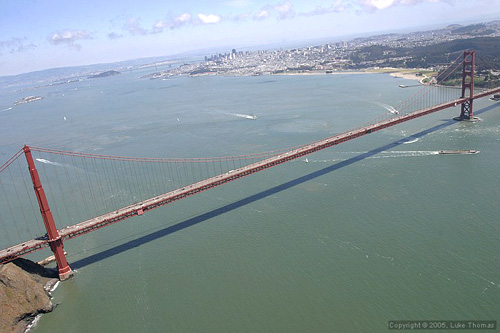Golden Gate Bridge suicides increase
Merits of reporting numbers in dispute

Photo(s) by
Luke Thomas
By Brigid Gaffikin, Bay City News Service
January 18, 2007
In a break from the usual practice of Bay Area law enforcement
and government agencies, Marin County Coroner Kenneth Holmes yesterday
released detailed information about suicides from the Golden Gate
Bridge in 2006.
At least 34 people died after jumping from the bridge last year,
a number that could increase at the conclusions of ongoing investigations
into other deaths that appeared to be Golden Gate Bridge suicides,
Holmes said.
That total could have been much higher were it not for the efforts
of the California Highway Patrol talking some 70 suicidal people
out of jumping from the bridge, he said.
CHP Officer Mary Ziegenbein, a spokeswoman for the Marin County
area, said the agency neither keeps an official count of suicides
on the bridge nor reports numbers. The CHP also doesn't track
trends in suicides, she said.
According to Holmes, more than 1,250 people have died after jumping
from the bridge since it was constructed almost 70 years ago and
only 26 people have survived jumping from the span.
Some 85 percent of bridge suicide victims the Marin County coroner's
office received were people from the Bay Area, he said.
Some bodies wash ashore in other counties and officials there
are responsible for determining the cause of manner of those deaths,
he said.
Safety on the span is monitored by both the CHP and employees
of the Golden Gate Bridge Highway and Transportation District,
bridge district spokeswoman Mary Currie said.
Currie said she's concerned about drawing attention to suicides
and that media interest in the topic could contribute to increased
suicides.
There were 622 suicides in the nine Bay Area counties in 2005,
and 599 of those were not involving the Golden Gate Bridge, Currie
said.
In 2005 there were 23 suicides from the bridge, and in 2004,
24, according to bridge district figures, which can differ slightly
from those provided by the coroner's office, she said.
Bridge deaths received renewed attention last year with the news
of a new study to fund research into options for a suicide barrier
and the release of a documentary about suicides from the 4,200-foot-long
span.
"The copycat phenomenon'' is real, Currie said. "The
coroner himself would tell you the copycat phenomenon exists.''
Holmes was not available for comment.
Currie said the bridge saw a spike in suicides in May and in
December last year.
In fact, suicides "were up dramatically in 2006, which to
me and our organization directly reflects an increase in media
coverage, due to the Eric Steel film'' and coverage of a new two-year
study that is looking at a proposed suicide barrier on the bridge.
Steel's 2005 film "The Bridge'' includes footage of people
jumping from the Golden Gate Bridge in 2004 and interviews with
those affected by suicides from the span. The film was shown in
April at the San Francisco International Film Festival and was
screened in theaters nationwide beginning in the fall of 2006.
Currie said that, like Holmes, the bridge district estimates
some 70 to 80 percent of potential suicides are prevented. But
while the success rate in preventing bridge deaths has to be underscored,
she said, activity that appears to be linked to potential suicides
has also increased.
"That activity rate ... both successful and unsuccessful,
really spiked in 2006,'' Currie said.
The two-phase suicide barrier study started in mid-October and
the first phase, which involves assessing a multitude of design
variations for a barrier, is expected to be completed by early
May, Currie said.
More than 100 variations, which include netting configurations,
adding to existing railing and replacing railing, will be considered,
she said.
Some people opposed to a suicide barrier have made objections
on aesthetic grounds. But engineering considerations are also
an important factor.
"Any adjustment we make out on the bridge has an impact
on how the wind moves across the bridge,'' Currie explained.
"Every study starts out with throwing up a bunch of conceptual
designs and everybody looks at it and says, 'That's really ugly,'
or 'That costs too much,' so you don't get past that point,''
she said.
The current study, contracted to DMJM Harris Inc., is starting
with looking at wind dynamics and will provide valuable information
regarding the type of structure that can work, she said.
A second, environmental review phase of the study, which is running
to budget and on time, will begin in May.
By its completion, the study will offer a solution that is acceptable
from engineering, cultural and aesthetic perspectives, she said.
Currie said bridge district employees, from patrol officers to
ironworkers to painters, will continue to report anyone who appears
to be in danger.
"We don't hesitate ... if your instincts tell you something,
you call,'' she said.
Copyright © 2007 by Bay City News, Inc. -- Republication,
Rebroadcast or any other Reuse without the express written consent
of Bay City News, Inc. is prohibited.
####
|